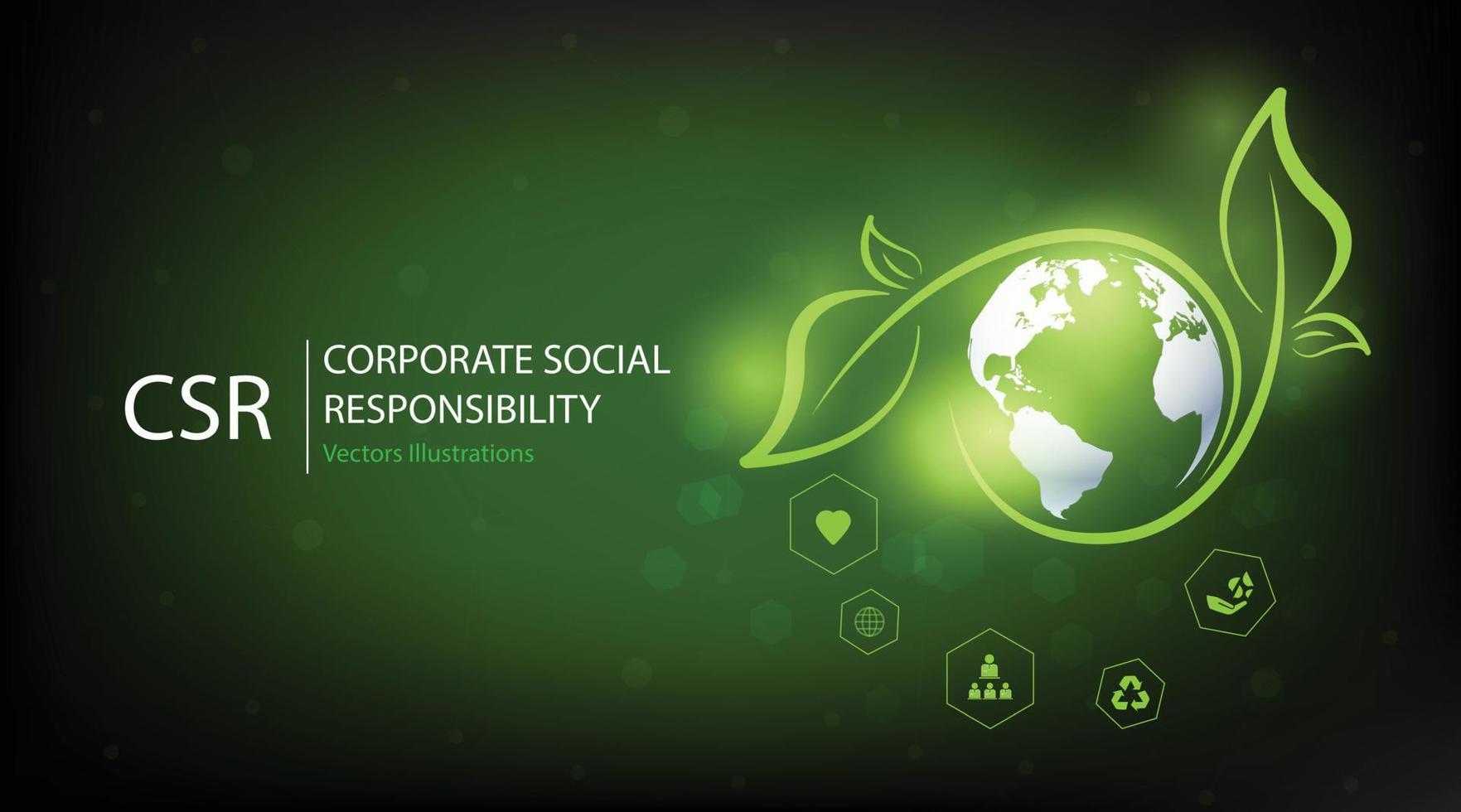
Corporate Social Responsibility (CSR) in a Green Economy: A Beginner’s Guide to Sustainable Business
In today’s rapidly changing world, businesses are realizing that success isn’t just about making a profit. It’s also about being a good citizen – caring for our planet and the people on it. This idea is at the heart of Corporate Social Responsibility (CSR), and it becomes even more vital when we talk about a Green Economy.
Imagine a world where businesses not only thrive financially but also help clean up the environment, treat their workers fairly, and give back to communities. That’s the vision CSR brings to the Green Economy. Let’s dive in and understand how these powerful concepts are transforming the business landscape.
What is Corporate Social Responsibility (CSR)?
At its simplest, Corporate Social Responsibility (CSR) is about how a company manages its impact on society and the environment. It’s a commitment by businesses to behave ethically and contribute to sustainable development, rather than just focusing on making money.
Think of it as a company’s "conscience." Instead of just following laws, CSR means going above and beyond to do what’s right.
Key Pillars of CSR often include:
- Environmental Responsibility: Reducing pollution, managing waste, conserving natural resources, and promoting eco-friendly practices.
- Ethical Labor Practices: Ensuring fair wages, safe working conditions, no child labor, and respecting human rights throughout the supply chain.
- Philanthropy & Community Engagement: Donating to charities, sponsoring local events, volunteering, and investing in community development projects.
- Fair Operating Practices: Dealing ethically with customers, suppliers, and competitors, avoiding corruption and bribery.
- Consumer Issues: Protecting consumer privacy, ensuring product safety, and providing clear, honest information.
In essence, CSR is about companies taking ownership of their actions and considering the broader impact they have on people, the planet, and profits – often called the "Triple Bottom Line."
Understanding the Green Economy
The concept of a Green Economy is all about achieving economic growth while protecting the environment. It’s a shift from the traditional "take, make, dispose" model to one that is more sustainable and resource-efficient.
Think of it as an economy that aims to:
- Reduce environmental risks: Minimizing pollution, carbon emissions, and the depletion of natural resources.
- Increase resource efficiency: Using less energy, water, and raw materials to produce goods and services.
- Promote social equity: Ensuring that everyone benefits from economic development, including job creation and poverty eradication.
Key Characteristics of a Green Economy:
- Renewable Energy: Shifting from fossil fuels (like coal and oil) to clean energy sources (like solar, wind, hydro).
- Waste Reduction & Circular Economy: Designing products to last longer, be reused, repaired, and recycled, minimizing waste and pollution.
- Sustainable Agriculture: Farming practices that protect soil, water, and biodiversity.
- Green Buildings & Infrastructure: Designing buildings that are energy-efficient and use sustainable materials.
- Clean Transportation: Promoting electric vehicles, public transport, and cycling.
- Biodiversity Conservation: Protecting diverse plant and animal life and their habitats.
The Green Economy isn’t just an environmental concept; it’s an economic strategy that creates new industries, jobs, and investment opportunities centered around sustainability.
The Crucial Connection: CSR in a Green Economy
This is where the magic happens! CSR and the Green Economy are not separate ideas; they are two sides of the same coin. For a business to be truly responsible today, it must consider its environmental footprint. And for an economy to be truly "green," businesses must adopt CSR principles.
CSR in a Green Economy means companies actively integrate environmental sustainability into their core business strategies and operations, alongside their social and ethical responsibilities. It’s about being profitable while being planet-friendly and people-friendly.
Why are they so closely linked?
- Shared Goals: Both aim for a better future – one that is sustainable, equitable, and prosperous.
- Interdependence: Environmental degradation (a Green Economy concern) often leads to social problems (a CSR concern), like health issues or displacement. Conversely, strong social practices (CSR) can support environmental protection (Green Economy), for example, by educating communities on conservation.
- Market Demand: Consumers, investors, and employees increasingly demand that companies operate sustainably.
Key Pillars of Green CSR
When CSR meets the Green Economy, specific areas of focus emerge for businesses:
1. Environmental Stewardship & Resource Efficiency
This is the most direct link. Companies commit to minimizing their negative impact on the environment.
- Reducing Carbon Footprint:
- Switching to renewable energy sources (solar panels on factories, wind power for offices).
- Improving energy efficiency (LED lighting, smart thermostats, efficient machinery).
- Optimizing logistics to reduce fuel consumption (efficient delivery routes, electric vehicle fleets).
- Waste Management & Circularity:
- Implementing robust recycling programs.
- Designing products for longevity, repairability, and recyclability (e.g., using recycled materials, offering take-back programs).
- Minimizing waste in production processes.
- Composting organic waste.
- Water Conservation:
- Reducing water usage in manufacturing processes.
- Implementing rainwater harvesting systems.
- Treating and reusing wastewater.
- Sustainable Sourcing:
- Choosing raw materials that are ethically and sustainably harvested (e.g., certified timber, organic cotton).
- Prioritizing local suppliers to reduce transportation emissions.
2. Ethical Supply Chains with a Green Lens
A company’s responsibility extends beyond its own walls to its entire supply chain.
- Supplier Audits: Ensuring suppliers meet environmental standards (e.g., no illegal deforestation, responsible waste disposal).
- Transparency: Knowing where materials come from and how they are produced.
- Promoting Green Practices Downstream: Encouraging suppliers to adopt their own sustainable practices, such as reducing their emissions or improving labor conditions.
- Fair Labor and Environmental Standards: Ensuring that workers in the supply chain (often in developing countries) are paid fairly, work in safe conditions, and are not exploited, while also adhering to environmental regulations.
3. Eco-Innovation & Sustainable Products/Services
This pillar focuses on developing new, greener ways of doing business and new products that help solve environmental problems.
- Research & Development: Investing in R&D for greener technologies, materials, and processes.
- Sustainable Product Design: Creating products that are durable, energy-efficient, non-toxic, and easy to recycle or compost.
- Service Transformation: Developing services that promote sustainability (e.g., car-sharing apps, repair services, product-as-a-service models).
- Certification: Obtaining certifications like LEED (for green buildings) or Fair Trade (for ethically sourced products) to demonstrate commitment.
4. Community Engagement & Social Equity with an Environmental Focus
CSR in a Green Economy also involves supporting the communities in which businesses operate, especially concerning environmental justice.
- Environmental Education: Sponsoring programs that educate local communities about sustainability.
- Local Green Initiatives: Supporting local parks, clean-up drives, or urban gardening projects.
- Green Job Creation: Investing in training and employment opportunities in renewable energy, recycling, and other green sectors.
- Addressing Environmental Justice: Ensuring that low-income or marginalized communities are not disproportionately affected by pollution or lack of access to green spaces.
5. Transparent Reporting & Accountability
For CSR efforts to be credible, companies must be open about their progress and challenges.
- Sustainability Reports: Publishing regular reports detailing environmental performance (e.g., carbon emissions, water usage, waste generated).
- Setting Measurable Goals: Defining clear, quantifiable targets for environmental improvement (e.g., "reduce emissions by 30% by 2030").
- External Verification: Having sustainability reports audited by independent third parties to ensure accuracy.
- Engaging Stakeholders: Communicating openly with customers, employees, investors, and community groups about sustainability efforts.
Benefits of Embracing Green CSR
Adopting a strong Green CSR strategy isn’t just about "doing good"; it’s also smart business.
For the Planet:
- Reduced Environmental Impact: Less pollution, lower carbon emissions, conserved resources.
- Biodiversity Protection: Minimizing harm to ecosystems and wildlife.
- Climate Change Mitigation: Contributing to global efforts to slow down global warming.
- Healthier Ecosystems: Cleaner air, water, and soil for all living things.
For the Business:
- Enhanced Brand Reputation & Image: Companies known for their green efforts attract more customers and build trust.
- Increased Customer Loyalty: Environmentally conscious consumers prefer to buy from responsible brands.
- Attracting and Retaining Talent: Employees, especially younger generations, want to work for companies that align with their values.
- Cost Savings: Efficiency measures (e.g., energy, water, waste reduction) can significantly lower operating costs.
- Risk Management: Proactively addressing environmental issues reduces regulatory risks, fines, and potential PR crises.
- Innovation & Competitive Advantage: Green initiatives often spark new ideas, leading to innovative products and services that stand out in the market.
- Access to Capital: Investors are increasingly looking at ESG (Environmental, Social, Governance) factors when making investment decisions.
- Compliance & Future-Proofing: Staying ahead of environmental regulations and anticipating future market trends.
For Society:
- Improved Public Health: Cleaner environments lead to fewer respiratory diseases and other health issues.
- Green Job Creation: Growth in renewable energy, recycling, and sustainable industries creates new employment opportunities.
- Stronger Communities: Companies investing in local environmental projects foster healthier, more resilient communities.
- Sustainable Development: Contributing to a more equitable and prosperous future for everyone.
Challenges and How to Overcome Them
While the benefits are clear, implementing Green CSR isn’t without its hurdles.
- Perceived High Costs: Initial investment in green technology or sustainable practices can seem expensive.
- Solution: Focus on long-term savings, government incentives, and the potential for new revenue streams. Start with small, manageable changes.
- "Greenwashing" Skepticism: Consumers and the public are wary of companies making false or exaggerated environmental claims.
- Solution: Be genuinely committed, transparent, and back up claims with data and independent verification. Authenticity is key.
- Complexity of Supply Chains: Tracking environmental and social performance across a global supply chain can be daunting.
- Solution: Start with key suppliers, use technology for tracking, and collaborate with industry groups.
- Lack of Internal Knowledge: Employees might not know how to implement green practices.
- Solution: Invest in training, foster a culture of sustainability, and empower employees to be agents of change.
- Measuring Impact: Quantifying the exact environmental and social impact can be challenging.
- Solution: Use established reporting frameworks (like GRI – Global Reporting Initiative), set clear metrics, and track progress consistently.
Getting Started with Green CSR: Practical Steps for Businesses
Feeling inspired? Here’s how a company can begin its journey towards Green CSR:
- Assess Your Current Footprint:
- Measure your energy consumption, water usage, waste generation, and carbon emissions. You can’t improve what you don’t measure!
- Look at your supply chain: Where do your materials come from? How are they produced?
- Set Clear Goals & Commitments:
- Based on your assessment, set specific, measurable, achievable, relevant, and time-bound (SMART) goals (e.g., "Reduce electricity consumption by 15% in two years").
- Make a public commitment to these goals.
- Engage Employees & Stakeholders:
- Educate your team about Green CSR and get their buy-in. Encourage their ideas and involvement.
- Communicate with customers, suppliers, and investors about your efforts and listen to their feedback.
- Implement Green Practices:
- Start with low-hanging fruit (e.g., switching to LED lights, better recycling).
- Explore sustainable sourcing, renewable energy options, and waste reduction strategies.
- Look for opportunities for eco-innovation in your products or services.
- Measure, Report, and Improve:
- Regularly track your progress against your goals.
- Publish sustainability reports to be transparent about your successes and challenges.
- Use the data to continuously improve your Green CSR strategy.
- Seek relevant certifications to validate your efforts.
Conclusion
Corporate Social Responsibility in a Green Economy is no longer a niche concept; it’s becoming a fundamental requirement for sustainable business in the 21st century. It’s about recognizing that the health of our planet and the well-being of society are directly linked to long-term economic prosperity.
By integrating environmental stewardship, ethical practices, and social engagement into their core operations, businesses can not only reduce their negative impact but also drive innovation, build stronger brands, attract top talent, and secure their place in a future that demands both profit and purpose. The journey towards a greener, more responsible business world is a collective one, and every step, no matter how small, makes a significant difference.



Post Comment